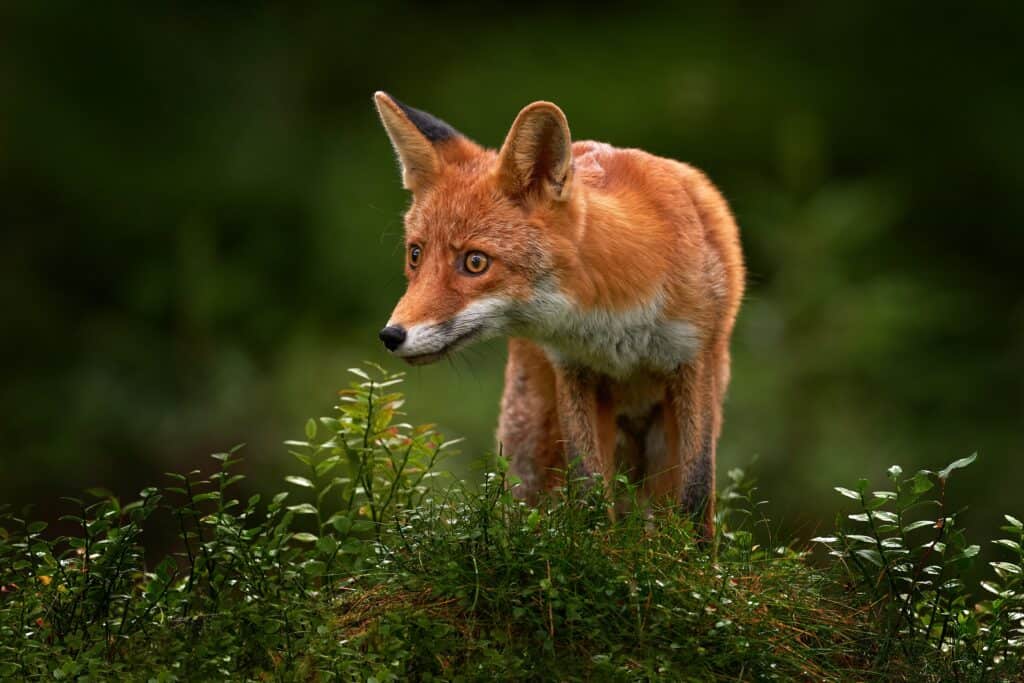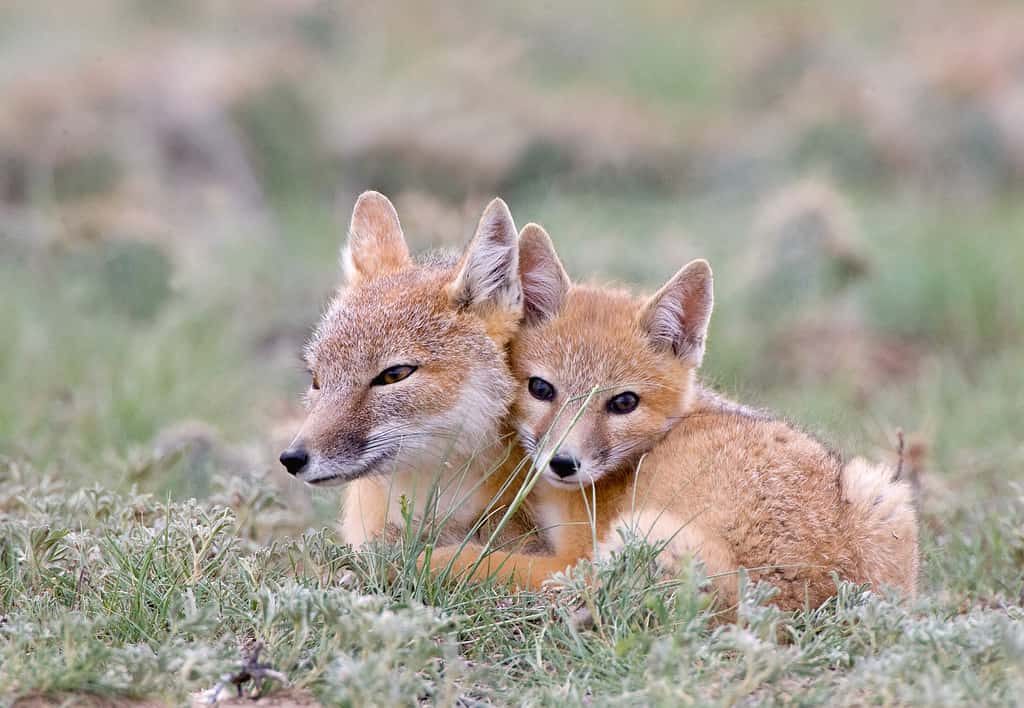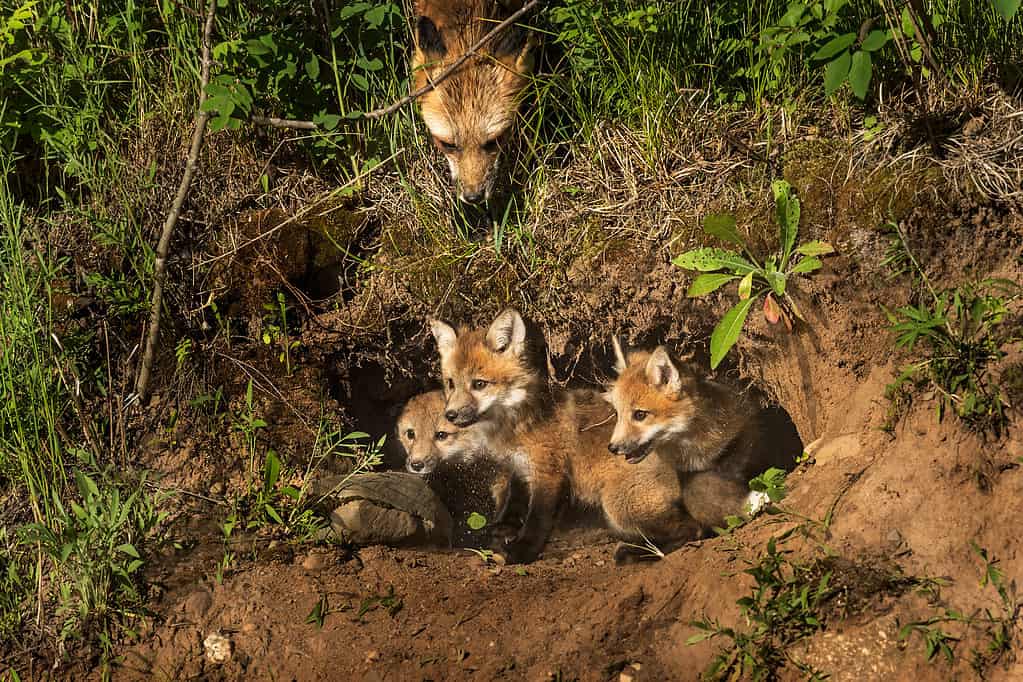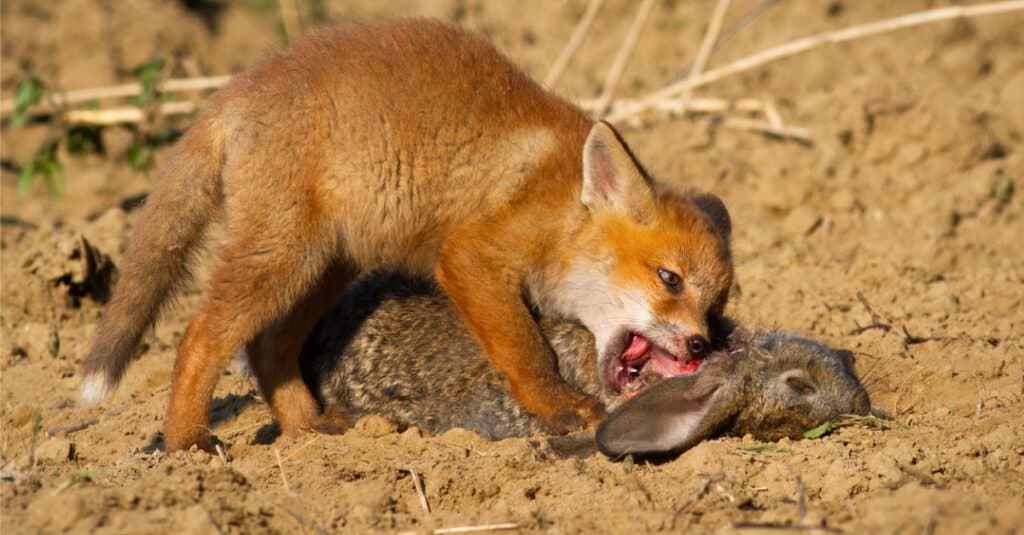Get ready to discover the extraordinary foxes living throughout Oklahoma. There are three species in total, and each one is unique. Take, for instance, the tiny swift fox, known for its adorable facial expressions, or the red fox with its famously bushy tail. And then there’s the agile gray fox that can scale trees!
Understanding fox behavior is crucial for effective conservation and management of populations. Follow along as we present all the information you need to know about these cute critters and where you can find them in Oklahoma.
Foxes in Oklahoma Key Points
- Oklahoma is home to three species of foxes: the gray, red, and swift fox.
- The gray fox can be distinguished by its gray fur along the back and face, reddish-brown fur on the sides, and a long bushy tail with a black stripe on top.
- Gray foxes are excellent climbers and can scale trees quickly using their sharp claws.
- Red foxes in Oklahoma are easily recognized by their red coat and bushy, white-tipped tail.
- Red foxes have a wide distribution and can survive in various habitats, including farmlands, forests, urban areas, and semi-arid regions.
- Swift foxes, the smallest of the fox species in Oklahoma, have slender bodies, a long bushy tail, and a coat that is a mixture of yellow, white, and tan.
- Swift foxes prefer open areas with short grass, such as grasslands and prairies, where they can find cover for hunting and suitable denning opportunities.
- Gray foxes are lightweight, with males weighing up to 15 pounds and females being slightly smaller at around 8 pounds.
- The average lifespan of a gray fox in the wild is six to eight years, although it can vary depending on factors like food sources, location, and health.
- Foxes in Oklahoma play important roles in the ecosystem by helping control populations of rodents and other small animals.
Gray Foxes in Oklahoma

Gray foxes live in Oklahoma.
©sunsinger/Shutterstock.com
Oklahoma is home to the agile gray fox. Sometimes, it’s easy to confuse the gray fox with other species, but as long as you know the right trick, you can easily tell them apart. Gray foxes have gray fur along the back and face and reddish-brown fur on their sides and tail. Look at the tail closely, and you’ll notice a black stripe running along the top. This is how you know you’re looking at a gray fox.
Renowned for their climbing abilities, gray foxes are one of the many animals that can climb trees. And they’re fast too! They can scale a tree in a matter of seconds. They use their long, sharp claws to climb up and down the trunk and jump from branch to branch.
Since they’re tiny, it’s easy for gray foxes to hop around. Males can weigh 15 pounds, and females are usually slightly smaller, weighing in at 8 pounds.
Gray foxes live six to eight years in the wild, and sometimes longer. Their longevity depends on food sources, location, and their health. These quaint woodland creatures love to live in dense forests with plenty of cover. Their gray coloration helps them camouflage into the environment.
Gray fox mating season in Oklahoma is usually between January and April. However, the exact month depends on the weather. The gestation period is less than an average of 53 days. A gray fox mom can have a litter of up to seven babies and fox babies are called kits. To take care of her young, the female gets a den ready and cares for the kits. And it’s the male’s job to go out and find the food for the entire family.
Red Foxes in Oklahoma

Red foxes can survive in various habitats, such as farmlands, forests, and urban settings.
©Ondrej Prosicky/Shutterstock.com
Now, let’s dive into the fascinating world of red foxes in Oklahoma. Red foxes are easily recognized by their red coat and bushy, white-tipped tail. These foxes can also display yellow, gold, and black colors.
You can find red foxes throughout the United States because they have a wide distribution, including Oklahoma. These foxes are highly adaptable and can survive in various habitats. For instance, red foxes thrive in farmlands, forests, urban settings, and semi-arid areas.
Let’s test your fox knowledge. Which fox is bigger? Is it the red fox? Or the gray fox? If you guessed red fox, you’re right!
Red foxes are a slightly larger species and can weigh up to 30 pounds on average. Adults weigh 10 to 15 pounds, and this species can live for about eight years in the wild.
Similar to the gray fox, the mating season depends on food availability and peak breeding activity. On average, mating season for red foxes in Oklahoma takes place between December and April. After a gestation period of 52 days, the female red fox gives birth to a litter. The litter can have as many as three to six kits.
Swift Foxes in Oklahoma

Swift foxes usually weigh between 5 to 7 pounds.
©Rob Palmer Photography/Shutterstock.com
The third fox species in Oklahoma is the swift fox. Swift foxes are one of the smallest species in the fox family. At shoulder height, they’re usually no taller than 16 inches. These little guys weigh between 5 to 7 pounds and have slender bodies with long bushy tails. Their coat is usually a mixture of yellow, white, and tan. Their coloration gives them the perfect camouflage in a grassland habitat.
Swift foxes love living in the grasslands and prairies of North America, just like the fields Oklahoma has to offer. They prefer wide open areas with short grass. These types of environments provide them with cover for hunting and opportunities for denning. You can also find swift foxes in desert areas with the right type of vegetation.
What do these tiny foxes like to eat? Their diet consists of small mammals, including mice, ground squirrels, and rabbits. As a nocturnal species, they hunt these creatures under the cover of darkness.
Depending on when you visit Oklahoma, you might come across baby swift foxes or pups. Their breeding season begins in the late winter or early spring and has a gestation period of 51 to 53 days. When the female fox gives birth, she usually has a litter of three to six pups. The swift fox pups are born blind and rely on their mother for food and protection from predators.
What Eats Foxes in Oklahoma?

Mountain lions are one of the fox’s many predators.
©iStock.com/SandmanXX
Being a fox means you always have to be on the lookout for hungry predators. Young red foxes are especially vulnerable to predation by eagles. These large birds of prey can swoop down and snatch a young fox from the ground.
Coyotes are also known for hunting foxes. These wild canines will hunt young and adult foxes. One of the reasons they hunt them is because they consider foxes to be competition by eliminating the population. By reducing the population, coyotes don’t have to compete so much for food sources.
Wolves also target mature red foxes. However, a wolf is most likely to go after a fox if it’s low on food. Otherwise, wolves prefer to prey on animals such as deer and rabbits. Other predators that foxes have to look out for include mountain lions, bears, and, of course, humans.
Bobcats are another creature foxes have to look out for. This video shows a fox making a speedy U-turn it after spotting a hungry bobcat. Further, since lynxes are carnivores, they enjoy dining on a variety of mammals, including young and adult foxes.
Fox vs. Coyote: How to Tell Them Apart

The first time you see a fox in the wild, you’ll be so thrilled you might not know what you’re looking at. It can be easy to mistake a fox for a coyote. After all, they both belong to the Canidae family. To help you tell these two species apart, we’ve put together a few of their key differences.
For starters, foxes are much smaller than coyotes, and they have a more diverse appearance. Their fur coats boast more colors, and their patterns are more unique. Meanwhile, coyotes are primarily a mixture of muted colors like tan and black. Their fur, though, sometimes has reddish undertones around the ears and face.
Next, look at the animal’s tail, as that’s one of the best ways to identify what you’re looking at. Foxes have long, bushy tails that come in different colors. A fox’s tail can be red, gray, silver, and even yellow-brown. A coyote’s tail, on the other hand, can range from silver to gray to black. The tip of the coyote’s tail is also always black.
Another difference is the sounds that these animals make. If you hear a long howl in the middle of the night, you’re listening to a coyote. If you hear a scream, you’re listening to a fox.
Fox Dens and Habitat

Fox dens have an entrance, ramp, and main room.
©Geoffrey Kuchera/Shutterstock.com
Now that you know the different types of foxes that live in Oklahoma, as well as the predators they face, let’s talk about where they live. Foxes live in dens. Dens are tunnels dug under various locations, like trees, shrubs, or large rocks.
A normal fox den will have a section that includes an entrance, a ramp, and a main space. There are also multiple rooms for storing food.
Multiple Dens
Foxes are creatures that like to have a lot of real estate. It’s normal for a fox to have several dens. They usually have one main den and a backup den. Sometimes, the young inherit dens from their parents, and the burrows can be used generation after generation.
Whether or not a den is passed on to kits depends on the food availability, location, and safety. If there’s a lot of human activity nearby, the fox family might decide to move for the next generation.
How to Spot a Fox Den
In folktales and fables, foxes always play a mischievous, clever character. They’re often portrayed as the trickster. And for good reason, too. These creatures are super sneaky, especially when it comes to hiding their denning locations.
Fox dens can be almost impossible to spot unless you know exactly what you’re looking for. The average entrance hole of fox dens is at least four inches in diameter. Sometimes traces of food that didn’t make it into the den can be a dead giveaway that a fox is nearby. Foxes also marked their territory with urine and distinct smells. If you start noticing a strange odor in your backyard and seeing food scraps lying around, there might be a fox den on your property.
Fox Den Spring Cleaning
Did you know that foxes take part in spring cleaning, too? During the springtime, foxes clean their dens by removing excess soil with their four paws. Picture a cute red fox kicking the dirt out of its den with its tiny legs. As the mother fox cleans the den, the kits usually play on the trampled debris.
Foxes are animals that exhibit seasonal behaviors. So long as everything is safe, they return to their dens in the spring. But they’ll leave them if there are predators, human influences, or the spread of disease. They’ll also move if food sources become unavailable.
Foxes and Food Caching

Red foxes love to store their food for when times are tough.
©iStock.com/JMrocek
Red foxes are famous for storing their food. They’ll hide a surplus of food in special places to get when they need it the most. In an effort to discover how good their memories are, researchers launched a study on the red foxes food-caching behavior. What did they discover?
Using special binoculars and radio tags, they were able to track the foxes throughout the experiment. The results showed that red foxes are excellent at rediscovering hidden food. They can remember where they hid food, a long time after storing it. Other animals that practice storing food include squirrels, woodpeckers, hamsters, and brown bears. Brown bears will cache large prey to protect it from spoiling or being discovered by scavengers.
A Study on the Fox’s Diet
Studying fox diets helps conservationists understand predator-prey relationships better. A study was done with three foxes, all healthy and well taken care of. They were given food like small rodents, rabbits, and birds. They wanted to figure out how much food the foxes ate by looking at the foxes’ poop.
During one part of the study, the researchers found that, on average, each of the three foxes ate around 378 grams of food every day for 191 days. This number was slightly below what they thought the foxes would eat. Adult red foxes typically need around 500 grams of food to be at their best. It just goes to show that a fox’s exact dietary needs vary from one animal to the next. Their age, size, and location all impact how much food they need.
More Mammals in Oklahoma
Foxes aren’t the only mammals you’ll find in Oklahoma. Here’s a short list of other mammals you can find on your wildlife-watching adventure.
- American bison
- Badger
- Black bear
- Coyote
- Bobcat
- Black-tailed jackrabbit
- Eastern chipmunk
- Black-tailed prairie dog
Oklahoma is home to the American bison, which is often mistaken for a buffalo. Bison are the largest mammals in North America. They have a huge hump of muscle on their back, similar to the hump that a grizzly bear has. This hump of muscle helps them push snow out of their way.
Final Thoughts
Now you know all about the three fox species that live in Oklahoma, the red fox, kit fox, and swift fox. Gray foxes have a distinguishing feature, like a patch of gray fur along their back and face. Red foxes are easily identified by their red coat and bushy, white-tipped tail, and swift foxes are the tiniest of both species.
Foxes play a big role in Oklahoma’s ecosystem. They help control populations of rodents and other small animals. Since these species are mainly nocturnal, your best chances for spotting a fox are at dawn and dusk. If you’re going to Oklahoma, set up a chair by a big open field as the sun goes down, and maybe you’ll see a red fox embarking on its nightly hunt.
The photo featured at the top of this post is © taviphoto/Shutterstock.com
Thank you for reading! Have some feedback for us? Contact the AZ Animals editorial team.






